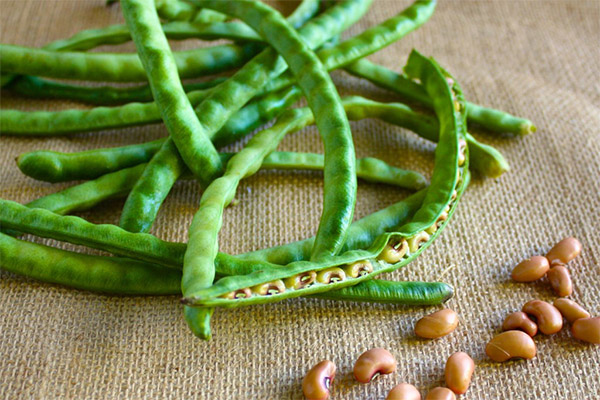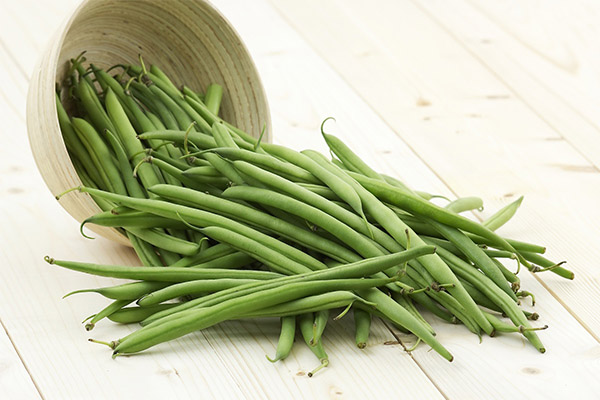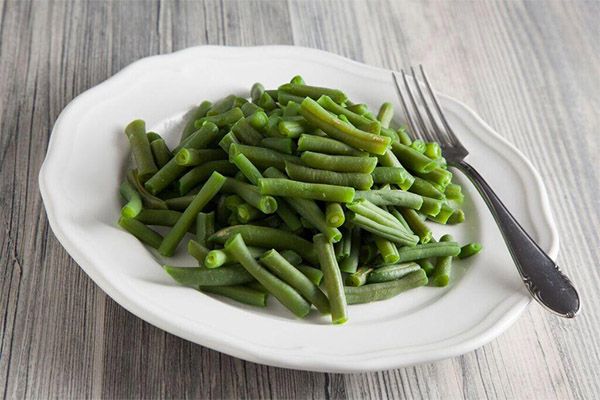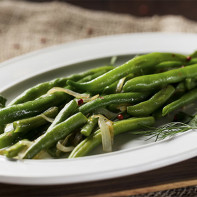Easy and tasty snack of string beans has become very popular among supporters of proper nutrition and healthy lifestyle. Young beans are a treasure trove of useful substances and have almost no contraindications, thanks to which they are included even in children’s and dietary diets. What are the valuable properties of this product and how to use it, let’s tell in detail.
Chemical composition of string beans
The high dietary value of string beans lies in the valuable natural components with which they are rich.

- It has healthy plant proteins that are essential for the healthy functioning of the body.
- The high content of dietary fiber provides colon cleansing and normalization of peristalsis.
- Complex carbohydrates provide all-day energy.
The rich vitamin composition keeps the body and immune system in shape. Beans contain:
- B vitamins, essential for nervous regulation and good metabolism.
- Vitamin K, which ensures normal blood clotting.
- Vitamin A and beta-carotene, which promote cell regeneration, maintain excellent vision, and prevent inflammation.
- The strongest antioxidant is vitamin C, which strengthens and cleanses cells.
- Vitamin E, which affects reproductive ability and keeps skin beautiful and supple.
The mineral composition of young beans is represented by:
- Magnesium, which supports the health of the nervous system.
- Calcium, essential for proper heart function and maintaining the strength of bones and horny tissues.
- Potassium, which stimulates the kidneys and normal heart rhythm.
- Iron and copper, which are involved in hematopoiesis and support normal digestion.
- Zinc, needed for healthy skin and hormonal balance.
- Sulfur, which protects the body from poisoning.
- Phosphorus, which takes part in nervous regulation, as well as manganese and other beneficial components.
It is important to know that string beans are rich in antioxidants as well as arginine, an enzyme that helps lower blood sugar, making them safe to eat for diabetes.
Nutritional value and calories
Green beans, that is, young, not yet ripe pods, have a very low caloric value – only 25-30 kcal per 100 grams. They have almost no fat but plenty of protein and complex carbohydrates. As the beans mature and are cooked, they gain calories, which should be taken into account when formulating a dietary intake.
If you cook asparagus beans with oil, their energy value will increase significantly: in fried form up to 170 kcal, and in stewed form – up to 130 kcal. The right combination of products will benefit: due to oils will be better absorbed fat-soluble vitamins, so the beans can safely be cooked in a butter sauce or under vegetable oil.
It is also important to know that beans contain specific poisonous compounds: like all plants, the bean crop protects its fruit. These poisons disintegrate with heat treatment, so beans should not be eaten raw, but should be boiled or steamed for at least 15-20 minutes.
Useful properties of string beans
General benefits
Green beans are useful for general health and cleansing of the body. Its constant consumption will allow you to feel light, less distracted by the feeling of hunger, replenish the minerals in the body.

- It has anti-inflammatory properties and helps relieve symptoms of diarrhea, intestinal upset and poisoning.
- Helps fight colds and increases the body’s resistance.
- Strengthens organ health, stimulates tissue rejuvenation, removes toxins from the body, supporting kidney function.
- Strengthens the nerves, helps the body recover from stress, hard work, and emotional turmoil.
- Supports the heart and vascular system.
- Boosts metabolism and helps burn off excess deposits.
- Increases skin and muscle elasticity and accelerates regeneration processes.
- Maintains healthy blood composition.
The components of asparagus beans are natural to the body, so they are easily digested. However, overeating this product can slow down the absorption of some useful substances.
Note. Thanks to fiber, green beans establish a healthy digestion, so they are useful in the diet at any age.
For women
Women strive for slimness, so they are more often interested in weight loss diets. String beans are a great way to lose a few pounds while staying energetic and alert. Women who live in an active rhythm will appreciate the ability of asparagus pods to satiate the body, suppressing the feeling of hunger and allowing you to go about your business, forgetting about eating stress.
Also relevant to women is the property of beans to balance the emotional state and maintain hormonal balance. With regular consumption of legumes, girls experience fewer mood swings during menstruation and menopause, as well as during pregnancy.
For men
Men need zinc, which green beans are rich in, to prevent impotence and maintain prostate health. Regular inclusion of the product in the diet strengthens the heart and blood vessels, which is also very important for men who are more likely to suffer from heart disease. Beans can help maintain a healthy metabolism and feel more energetic when exercising.
For pregnant and lactating women
For women in pregnancy and nursing mothers, string beans are just a godsend in nutrition. It is very easy to digest without burdening the body, contains a lot of nutrients necessary for fetal development and improving milk quality, as well as reducing harmful cholesterol, which should not enter the body of the child.
Beans can help with mood swings, nausea in pregnancy, reduce the risk of constipation and hemorrhoids, help avoid the formation of pigmented spots on the skin. But you need to be careful: sometimes bean proteins cause allergic reactions, so you will have to give up the product.
At what age can I give green beans to children
It is green string beans, which actually does not cause allergies and indigestion, can be given to babies in the form of mashed potatoes from 8-10 months of life. The main thing is to boil the pods well and grind them into mush. A child will only need 1 teaspoon of mashed beans in combination with other vegetables. You can give the beans twice a week.
Be sure to monitor the reaction of the child’s body. If allergies appear, postpone acquaintance with the vegetable.
String beans in medicine
Official medicine suggests introducing green beans into the diet for wellness and warns in which diseases they should not be eaten. For example, beans are recommended for cardiovascular diseases, as well as for inflammatory processes.
- In cholecystitis.
- In hemorrhoids
- For colitis
- For gout
- for constipation
- For gastritis
- In pancreatitis
- In diabetes mellitus
In diabetes mellitus
Young fiber beans help burn excess fat deposits and also reduce blood sugar by up to 40%, so they are recommended to diabetic patients as a good staple. Not only do they help relieve the major symptoms of the disease, but they also improve skin health by increasing its elasticity, maintaining normal vision and blood pressure.
Important: The glycemic index of green string beans is 30 units.
For pancreatitis
In inflammation of the pancreas and other digestive organs, it is not recommended to use beans. However, there is a useful recipe for an infusion of beanstalks: 50 grams of dried material pour 0.5 liters of boiling water and insist 10-12 hours in a thermos. The dose is calculated individually, for this you need to consult a doctor.
For gastritis
Those who suffer from acute gastrointestinal diseases are not recommended to get carried away with dishes with green beans. In small quantities, the product will not harm, but can irritate sensitive mucous membranes, so before introducing it into the diet, it is necessary to discuss the diet with the doctor.
Folk medicine recipes based on green beans
Mature bean pods are recognized by alternative medicine as effective remedies in the treatment of many diseases. It can help with diseases of the gastrointestinal tract: gastritis with reduced acidity, inflammatory diseases of the gallbladder and liver.
Beans help with high blood pressure, weakness of the heart muscle, rheumatism. Not only the fruiting bodies of beans are used, but also the husks, which accumulated a lot of useful substances.

Pancreatitis
When problems with the pancreas, decoction of bean stems is effective, from which the inflammatory process is reduced, improving the well-being of the patient. Particular benefit decoction can bring people who simultaneously suffer from pancreatitis and diabetes.
Prescription:
- Take 50 grams of dry husks (from mature beans), pour them into a thermos.
- Boil 0.5 liters of water, pour it into the thermos.
- Infuse the mixture for 10 hours.
- Strain, shake before use.
The dose should be discussed with the treating physician who prescribes the main treatment.
Diabetes mellitus.
Not only unconventional, but also official medicine recognizes string beans as effective for diabetes mellitus. It is used as an additional method of treatment to the main one – medication. It is proved that already 10 hours after using the tincture or juice, the blood sugar content is reduced by up to 40%. Under the influence of useful substances of beans, the body produces insulin, and sugar is converted into glycogen.
A solution with a high concentration of active ingredients is used for healing:
- Take 3 cups of dried sashes, grind them.
- Pour the resulting dry base with 3 cups of water.
- Bring to a boil, simmer over low heat for 15 minutes.
- Decoction strain, take 100 g four times a day for half an hour before a meal.
To use this remedy, it is necessary to consult a physician.
For ailments of the cardiovascular system
Infusion of the stems is recommended to take to restore the normal functioning of the circulatory system. To do this, take 1 large spoonful of dried stems and add to it a glass of hot water. It is necessary to let the remedy to stand for half an hour and consume one third of a glass before a meal.
Bean juice for bursitis or mastitis
String beans are excellent against these diseases, especially in the early stages. It eliminates redness and inflammation. It is necessary to take bean juice 2 times a day, 100 ml for 2 weeks. The healing effect of this remedy will not make you wait long.
String beans for weight loss: benefits and uses
Due to the fact that the beans in pods are rich in valuable vegetable proteins and fiber, the product is actively used in dietary diets. It promotes colon cleansing and restores a healthy metabolism. In addition, it helps to get full faster during meals and feel invigorated throughout the day.
Legumes are easy to digest and allow you to get rid of the feeling of heaviness or heartburn that many people get when eating meat products. Beans are highly recommended on wellness diets:
- Diabetics and obese people to normalize blood composition and metabolism, and as a nutritious substitute for caloric foods.
- For people who have had heart attacks and for cardiovascular disease, to replace cholesterol-laden foods and reduce the burden on the body.
- For gastrointestinal diseases to normalize peristalsis and maintain normal acidity.
- Vegetarians who voluntarily give up meat, egg and dairy products.
- Children for the growth and development of the body.
- When losing weight, especially on low-carbohydrate diets, to keep energetic.
- In sports nutrition for drying out and gaining healthy muscle mass – many trainers recommend using this product.
Consumption of green beans helps to cleanse the body, has an antioxidant effect, and thus a rejuvenating effect. Beans are actively used in diets to unload the body, in the transition to a healthy lifestyle and for weight loss.
This product is usually used to replace fatty meats and some of the egg components, since beans are just as full of vitamins and minerals to keep the body healthy as they are, and beans have far fewer calories at the same time.
Thanks to beans normalize appetite, disappear traces of body fatigue, improve skin condition, general health and mood, and strengthen the nervous system. That’s why string beans are indispensable after the winter depression of the body.
It is recommended to consume vegetable protein food in the first half of the day, during the first meal or in lunch, otherwise the useful proteins will be worse absorbed. Bean breakfasts allow you to stay satiated for a long time and increase your productivity during the work day, and they increase your endurance during workouts.
What you can make with string beans
As a dietary product, green beans are cooked on steam: in this way it preserves all the useful components and comes to the optimal condition for digestion. When boiled, the product loses some of its valuable substances, so green beans are usually only tacked in boiling water.
Steamed beans contain a minimum of calories, but they are usually served with the addition of oil and spices.

To make delicious dishes with beans, they can be stewed with other vegetables in a sauce. Beans go well with broccoli, peppers, tomatoes, lettuce, carrots, celery, corn and other components. In addition, tasty pieces are added to first dishes: vegetable soups with smoked meats and hodgepodge.
Indian-style bean recipe
The pods are sliced and stewed with pieces of homemade paneer and carrots. Turmeric, garlic, and a little ginger are added to the dish.
Green bean omelet
The pods are chopped very finely diagonally, the same is done with leeks, shredded dill greens. Vegetables are fried in oil and poured with beaten eggs. The dish is sprinkled with herbs and garnished with tomatoes, if desired.
Hearty Beans and Mushrooms
Chunks of asparagus beans are stewed with onions, mushrooms are fried separately and mixed with the vegetables. The dish is seasoned with rosemary and lemon juice.
How to prepare string beans for the winter
One of the additional valuable qualities of green asparagus beans is considered to be the convenience of their preparation. The product can be stored for a long time to enjoy the healthy beans all year round. To save a maximum of useful properties and vitamins, the crop is frozen, but you can also preserve the beans at home without much hassle.
Freezing
To keep the product fresh for a long time, you can store the pods in the freezer. To do this, the beans are sorted out and washed of plaque. It is best to freeze the pods in one piece: then they will not wilt, will not discolor, and will remain useful. If you like to prepare vegetables for stews, you can cut the pods into 2-3 cm pieces.
The raw material is put in a container or spread out on foil in the open and placed in the freezer for a few hours. Once completely frozen, the beans can be bagged or covered in a container and stored at about -18 ºC degrees. After defrosting, the beans will be as fresh.
Canning
Asparagus beans can be preserved for the winter to store at room temperature. To do this, they can be salted or cooked in a sauce. In the first case, you get a semi-finished product. You need to sort and wash the beans, cut into slices of 2-3 cm and prepare a brine, as for peas: only salt and water.
Some housewives add a pinch of sugar for full flavor. Neither spices nor acid in this case is necessary. The beans are boiled in brine and rolled in sterile jars.
Another option – Korean-style pickling. For this, the chopped beans are generously poured with spices and vinegar, and then closed in jars. Beans can be combined with carrots, wheat sprouts and soy products.
The third method is a stew. Beans are stewed in a sweet tomato sauce with the addition of garlic, onions, and spices. The result is a flavorful snack in the vein of lecho, lobio, or sauté. Such a delicious snack is closed for the winter: it perfectly complements the festive table and is suitable for every day.
Hazards and contraindications
Although green beans carry a lot of health benefits, sometimes they cause individual discomfort. If you are prone to allergies to bean protein, you should try the product with caution. Also in a clogged intestine beans often cause bloating and gas.
Stringy varieties are notable for their higher content of fairly coarse fiber, which can cause a feeling of heaviness. In addition, legumes are not recommended to be combined with other starchy foods: flour and potato dishes – as well as meat, then the digestion process will go much easier.
Direct contraindications apply to people with kidney failure, nephritis, cystitis and GI diseases – in such cases, it is necessary to consult a doctor. But in general, the product is considered safe and dietary, which is why it is so popular in healthy eating programs around the planet.
How to choose and store string beans
To prevent a product grown with heavy fertilizers from coming to your table, buy asparagus beans only during the summer – the natural harvest season. If possible, of course, it is better to plant your own green beds of healthy beans.

When choosing, be sure to pay attention to the condition of the pods:
- The beans should be free of dark spots and damage, and the characteristic spider-like fungal growth.
- The pods must be fresh and juicy, uniformly green (or yellow, depending on the variety).
- Green beans are sold young, so their skin is quite fleshy, but there are varieties that are sold dried out. The dried out boat peels will have to be discarded, freeing up the grains.
- The pods should definitely have stalks on them, no cracks or breaks.
Fresh pods are stored in the refrigerator, in a vegetable container in a bag, separately from other vegetables. It is acceptable to store beans with tomatoes, cucumbers, zucchini, but not earthy root vegetables. Green product can lie 5-7 days, after that the beans will dry out and become tough, so if you are not going to cook the vegetable in the near future, it is better to freeze it.
Dry varieties can be stored in cloth bags or in a jar to dry. But dishes made from beans do not spoil for quite a long time, so they can be cooked at the rate of several servings.
Interesting facts about string beans
In the ancient world, the bean was cultivated on several continents: Egypt, China, and America. They came to Europe as an ornamental garden plant, and only in the 18th century did they begin to use beans as food. Green beans in pods were first cooked by the Italians, who were always famous for their balanced cuisine.
The younger the pods, the fleshier and juicier the walls of their crusts, and as the beans swell in this nutrient medium over time, the rinds dry out and become thinner. Grain beans are rich in starch and more caloric, while fresh young “tails” contain pure proteins, healthy compounds, and water.
The easy meal can be used in mono diets, as green pods contain a basic complex of vitamins and minerals, while not being boring in the diet and easily digested.
If you haven’t yet introduced asparagus bean dishes into your diet, be sure to try them for a change, and they may become your favorite treat.





The articles on this site are for information purposes only. The site administrators are not responsible for attempting to apply any recipe, advice or diet, nor do they guarantee that the information provided will help or harm you personally. Be cautious and always consult a doctor or nutritionist!
*All products recommended by thefirstdoc.com are selected by our editorial team. Some of our articles include affiliate links. If you buy something through one of these links, you help us earn a small commission from the seller and thus support the writing of useful and quality articles.






































